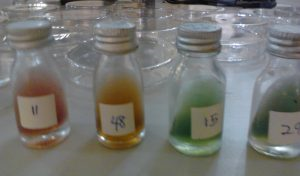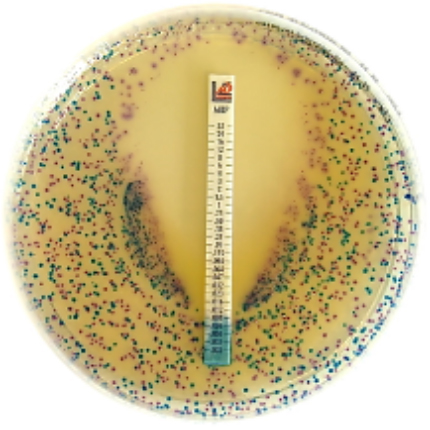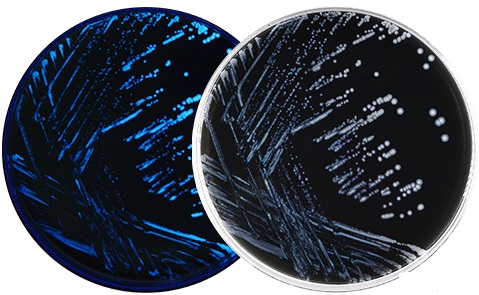Cetrimide selective agar is used for the selective cultivation and isolation of Pseudomonas aeruginosa isolates from clinical and non-clinical samples. The preparation of cetrimide selective agar is elaborated in this section. P. aeruginosa is a pigment-producing bacterium. The organism produces certain types of pigments including pyocyanin (blue-green pigment), pyomelanin (black pigment) and pyoverdine (yellow-green and fluorescent pigment) [Figure 1].
These pigments are also used for the morphological characterization of P. aeruginosa isolates. Cetrimide selective agar contains certain types of selective agent that allows only for the growth of P. aeruginosa, while suppressing the growth of other bacteria or microorganisms in the sample being cultured. These selective agents including cetrimide and glycerol helps to enhance pigment production in P. aeruginosa.
Cetrimide is inhibitory to the growth of many bacteria. In addition, cetrimide exhibits inhibitory actions on a wide variety of microorganisms including Pseudomonas species other than P. aeruginosa. This is why cetrimide selective agar is used for the selective isolation of P. aeruginosa from clinical and environmental samples. P. aeruginosa also produces a characteristic “corn taco” or “grape”-like odour, which makes cultures of P. aeruginosa to produce pungent odour in the laboratory.

Components of cetrimide selective agar base
The components of cetrimide selective agar base required for cetrimide selective agar preparation include:
- Cetrimide selective agar base- which is the solidifying agent
- Gelatin peptone
- Magnesium chloride
- Potassium sulphate
- Cetrimide
- pH – which is usually adjusted to 7.2 at 25 °C (or 77 °F)
Additional requirements: 10 % glycerol
MATERIALS
You require these materials to prepare your cetrimide selective agar: cetrimide selective agar base (usually comes in 500 g), 10 % glycerol, autoclave, conical flask, measuring cylinder, beaker, stirring rod, Bunsen burner, incubator, refrigerator, wire gauze, spatula, weighing balance, timer, cotton wool, aluminium foil, distilled water, Petri dish
STEP BY STEP PROTOCOL TO PREPARE CETRIMIDE SELECTIVE AGAR
- Weigh out 46.7 g of cetrimide selective agar powder using the weighing balance.
- Add 10 % glycerol to 1000 ml of distilled water.
- Suspend the 46.7 g of cetrimide selective agar powder in 1 litre (1000 ml) of distilled water already containing 10 % glycerol in a conical flask.
- Mix the solution by stirring to dissolve the agar.
- Bring the mixture to boil, by mild boiling of the mixture over a Bunsen burner flame. This helps to dissolve the agar completely. Monitor the boiling process closely in order to avoid charring the agar.
- Transfer the conical flask containing the boiled/mixed agar suspension to the autoclave.
- Sterilize the medium at 121 degrees Celsius at 15 psi (or 15 lbs of pressure) for 15 min in the autoclave.
- At the end of sterilization, allow the autoclave to return to normal (zero point) before opening. Otherwise the pressure built up in the autoclave will affect the quality and quantity of the prepared molten medium. More so, you may be affected by the steam from the autoclave due to the high pressure built up in the autoclave.
- Allow molten cetrimide selective agar medium to cool to about 45-50 degrees Celsius.
- Pour prepared molten medium into sterile Petri dish plates.
- Allow the poured plates on the bench to solidify.
- Do sterility check by incubating the poured plates in the incubator at 37 degrees Celsius for 18-24 h.
- At the end of incubation, check the plates for any sign of microbial growth (which is usually indicated by the presence of colony).
- Absence of colony on the plate means that your sterilization is good.
- You can now use your prepared cetrimide selective agar plates for your experiment OR store in the refrigerator at 4 degrees Celsius until use.
REFERENCES
Cheesbrough M (2006). District Laboratory Practice in Tropical Countries. Part 2 . Cambridge University Press, UK.
Discover more from #1 Microbiology Resource Hub
Subscribe to get the latest posts to your email.



